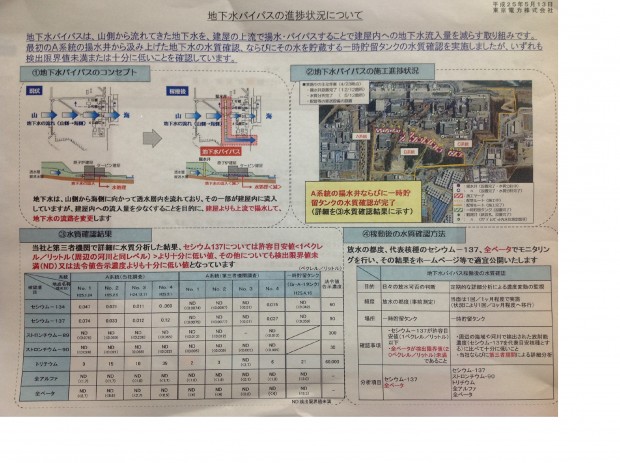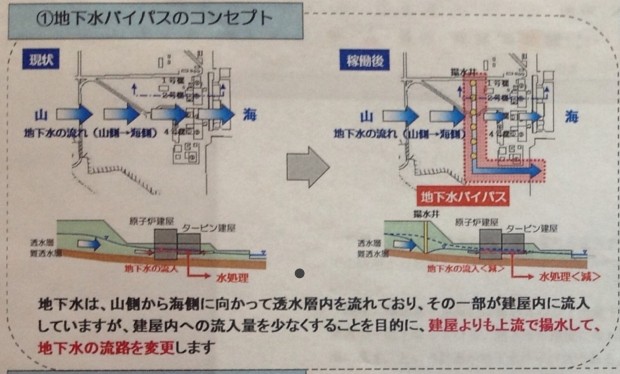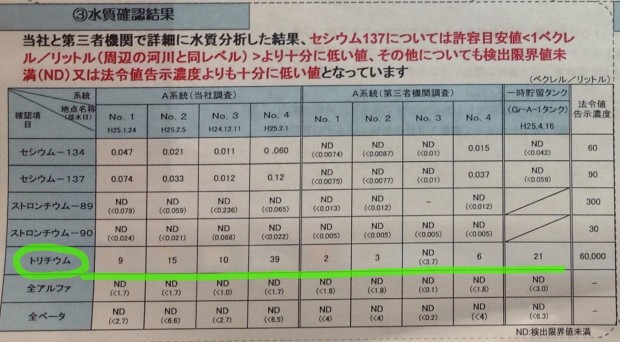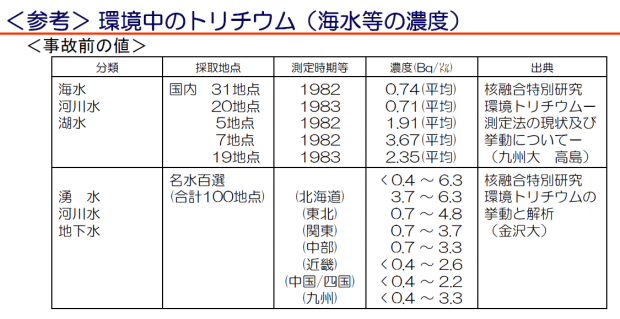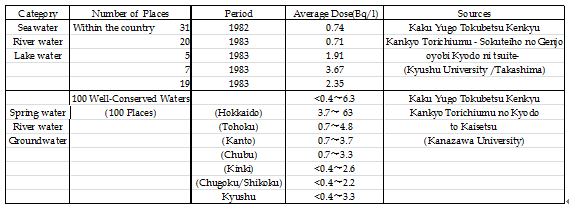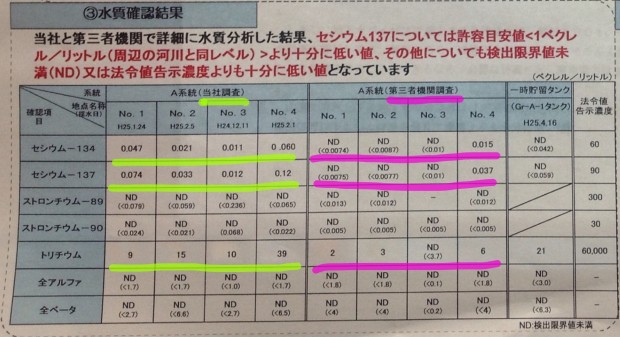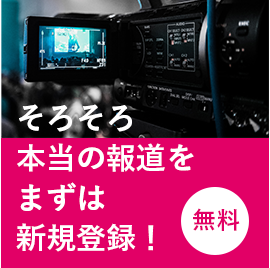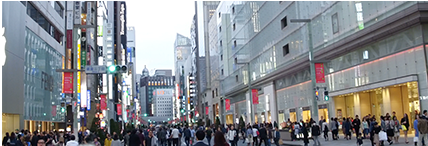Is the Plan to Pour Groundwater into the Sea Above Board? By MAKO OSHIDORI
Is the Plan to Pour Groundwater into the Sea Above Board? By MAKO OSHIDORI
May 14, 2013
Mako Oshidori of Yoshimoto Creative Agency is a member of the Manzai Kyokai (The Association for Stand-up Comedians) and of the Board of Directors of the Free Press Association of Japan. She regularly attends press conferences given by public authorities and TEPCO since the outbreak of the Great East Japan Earthquake. She also relentlessly does reporting on Fukushima and other disaster-affected areas. She presently writes columns for “DAYS JAPAN” and “MAGAZINE 9”. For donations, please go to the link below:
http://oshidori-mako.laff.jp/blog/2011/07/post-ad67.html. Thank you for your support!
On May 13, from 5:30 PM, at one of the press conferences regularly held by TEPCO, explanations were given about the progress of the groundwater bypass project.
Every day 400 tones of groundwater invade the Fukushima Daiichi Nuclear Plant. It’s one of the reasons why the volume of contaminated water constantly increases. The groundwater bypass project consists of pumping groundwater from the mountains and discharge it into the sea before it reaches the nuclear plant facilities.
However, only 100 tones of polluted water per day can be drained through the bypass, which means that every day 300 tones of groundwater pour into the nuclear facilities. In spite of that, TEPCO declares the project is worth being carried on if it can help reduce a bit of the volume of contaminated water.
The Federation of Fisheries Cooperative Associations of Fukushima Prefecture holds back the groundwater bypass project.
In order to obtain the consensus of concerned entities, explanations were given at the meeting of heads of Workers Unions of the Prefectural Federation of Fisheries Cooperative Associations, but without reaching any conclusions.
The declaration of the Prefectural Federation of Fisheries Cooperative Associations states:
1. The government and TEPCO have to provide more explanations about the necessity of the groundwater bypass project to members of the Federation since each of them has not yet come to a full recognition of the project.
2. The operation of the groundwater bypass is not to be decided by the Prefectural Federation of Fisheries Cooperative Associations, but through a consensus reached at the governmental level.
3. The opinion that the operation of the groundwater bypass per se does not represent a decisive groundwater policy has also been expressed. A drastic policy to address the groundwater issue needs to be presented in the future.
Results and the Method of Water Quality Tests
The levels of contamination of groundwater drained from the mountains “are the same as those detected in surrounding rivers”. The concentration of radioactive materials detected is below the margin or enough lower than the legally specified dose, which means that it is under the acceptable limit of 1 Bq/ liter of cesium -137.
The radioactivity dose notice is the “Notice on Dose Limits” issued by the Minister of Economy, Trade, and Industry in accordance with the “Rules for Commercial Nuclear Power Reactors concerning Installation, Operation, etc.”
The notice prescribes standards of contamination as follows:
(1) Dose limits to radiation workers
(2) Doses of radioactive materials detected in the air outside the control zone
(3) Doses of radiation detected in the waters outside the control zone
The figure 60,000 Bq/l on the table above represents the average dose limit in waste fluid or sewages for 3 months.
TEPCO declares that groundwater radioactivity doses are “the same as those sampled in the surrounding rivers”, but a comparison with TEPCO archives shows that, before the nuclear catastrophe the tritium dose was higher in seawater and river water than in groundwater.
http://www.tepco.co.jp/nu/fukushima-np/handouts/2013/images/handouts_130228_08-j.pdf
<Reference> Doses of Tritium Pollution of Seawater, etc.
Besides, concerns rise over the results of water purity tests. It is stated that radioactivity monitoring doses carried out by third party institutions turned out to be lower than the TEPCO dose control.
A glance at the water quality verification method reveals that only “third party institutions” are referred to. (The word kikan (organization, institution) was mistyped for kikan (period, term), though).
I asked, what are the “third party organizations” you are talking about? The answer was “Kaken and The General Environmental Technos”
Kaken.Co.Ltd http://www.kakenlabo.co.jp
The General Environmental Technos. Co. Ltd http://www.kanso.co.jp/aboutus/index.html
The intriguing fact is that The General Environmental Technos. Co. Ltd is a KEPCO owned corporation affiliated to the Kansai Electric Power Group.
Is a Kansai Electric Power Group affiliated corporation appropriate to be a third party organization?
The Presidency of the Federation of Electric Power Companies (FEPC) has been successively held by the Tokyo Electric Power Company (TEPCO), the Kansai Electric Power Company (KEPCO), and the Chubu Electric Power Company (CEPCO). Can a company affiliated to an Electric Power Company Group which has also been promoting nuclear power be called a “third party institution?”
- Is a company member of the Kansai Electric Power Group which has also been promoting nuclear power entitled to be a “third party institution?”, I continued . “We think it is a third party institution”, replied TEPCO.
- I hardly think so, but according to TEPCO what are the kind of companies that can be considered “third party institutions”?
“Any company that is not TEPCO is a third party institution”, went on TEPCO.
A third party institution is an independent organization that can operate as a reference or auditor in order to guarantee transparency.
The first party: the concerned party.
The second party: a party that shares interests with the concerned party.
The third party: a party that does not share interests with the concerned party.
(Second party inspection, second party certification, second party auditing can be done. For instance, in cases of verifications proceeded by a customer, parties that share interests can be controllers or inspectors.)
Is Kansai Electric Power Group suitable as a third party institution in order to conduct investigations about the purity of water for the project of discharging groundwater from the surroundings of Fukushima Daiichi Nuclear Plant into the sea? Isn’t it hard to confirm that it is “an independent third party that does not share interests with the concerned party”?
What about the possible land subsidence resulting from groundwater pumping?
I also raised the question of possible land subsidence as a consequence of groundwater discharge into the sea. “Land subsidence is unlikely to occur since it’s just going to be an operation of groundwater bypass”, is the unfathomable reply I received.
I went on inquiring about the method of evaluation and the calculations made regarding the matter, the reply was, “we are going to check”.
Concerning the radioactive materials that leaked into the ground from a water storage tank, the writer has already requested that all explanations be given about inspections made during construction.
Three patterns will be adopted to pump 1,000 tones of groundwater and discharge it into the sea each time (each day), but by regularly doing so what estimations are being done about the issue of land subsidence, what are the effects that this can have on the reactor coolant plumbing system, the building, and the tanks at Fukushima Daiichi Nuclear Plant? These are matters of concern to me.
Bearing in mind that a beforehand simulation test of the maximum capacity of the water storage tank in order to avoid land subsidence has not been done, what is TEPCO’s position on land subsidence, what will be the division in charge, and how is it going to deal with this matter?
The reply was, “the estimation of the full water storage capacity susceptible to cause land subsidence” was not envisaged. The full capacity of a water storage tank that can result in land subsidence is difficult to estimate, but the writer believes that in one way or another it was necessary to predict the effects that a huge volume of the scale of 14,000 or 11,000 tones of water could have on the ground.
As a matter of fact, transparency and credibility lack about all the above mentioned issues. TEPCO should take the back seat and allow a third party institution to be in charge. The writer requests that at least the country or a third party institution take the driving seat over matters related to the plan for the decommissioning of Fukushima Daiichi Nuclear Plant.
Request for an investigation by a third party body made up with NGOs and NPO
On May 13th the International environmental NGO Greenpeace Japan and Surfrider Foundation Japan have submitted a written request addressed to the C.E.O of TEPCO and to the Prime Minister of Japan.
They requested that the investigation on the plan to discharge groundwater from the surroundings of the Fukushima Daiichi Nuclear Plant into the sea be immediately entrusted to NGOs, Civil Society Organization and experts and that the results of the investigation be disclosed to the public.
I asked, how is TEPCO going to respond to the request? The reply was that the written request has already been received but that the content had still to be examined, which means that the reply was put off sine die.
I went on asking, if TEPCO has the plan to investigate and examine the issue of groundwater with the collaboration of NGOs, NPO, and other experts, since it’s not only the company that has caused a nuclear accident nor the country that has been promoting commercial nuclear power plants that have to investigate and evaluate the case. I said, in addition, that not only such an initiative would boast the credibility of TEPCO and secure transparency, but, most of all it will be beneficial to TEPCO itself since the division in charge is likely to give better and persuasive explanations. TEPCO responded that it had no such plans.
As to the sampling test of the groundwater, answering questions such as “from which level of the sea is the water going to be drained”, “how deep is the groundwater going to be sounded?” will affect the outcome of the operation.
For now, only TEPCO is at work for pumping operations. Isn’t a third party institution evaluation also needed?
I believe that the operation of pumping groundwater into the sea is extremely important, but the perquisite should be to make sure that groundwater is not radioactive polluted.
That’s why evaluations and analyzes done conjointly with NGOs, NPO, researchers, third party members not designated by TEPCO, and experts will guarantee transparency. Isn’t that this will be beneficial to TEPCO in the sense that I will contribute to the restoration of its credibility through the process of the execution of the project?
The writer truly wishes that, for the execution of the groundwater bypass project, TEPCO accepts to include evaluations and inspections from third party organizations and researchers not internally designated.
Addendum: The Tokyo Electric Power Company’s Assumption
The writer has previously conducted interviews and reporting on badges (personal dosimeters) used to measure the external exposure of the skin to radiation. On the 13th of May, the writer has asked a number of questions about badges. Answers received are noteworthy and I am going to highlight them below.
---- (Abridged) Are Chiyoda Technol and Nagase Landauer the companies that received the contract for monitoring badges or are there other companies?
----TEPCO: “These matters are related to the contract. They cannot be disclosed”.
----Chiyoda Technol, Nagase Landauer manufacture personal dosimeters. Dose measurement for decontamination operations are conducted in local communities and companies, for children badges, in hospitals, at universities, and research institutes, but all these entities disclose their contractors or do so upon request.
Is it because TEPCO requested that Chiyoda Technol and Nagase Landauer not to be disclosed as contractor companies?
TEPCO: Please, give us the time to make sure. Generally speaking, in our understanding, it’s the kind of contract we have signed”.
---- ??? Does your answer say that because you haven’t checked the nature of the contract you have signed, you are unable to respond to my question?
TEPCO: “It’s a contract as generally conceived”.
---- ??? The general assumption is that every local community, every company, every hospital discloses the company monitoring badges. In my view, the disclosure of the company that proceeds to badge tests is the general rule.
TEPCO: It means that it’s a general rule between our company and our partner company”
---- Anyway! Even if there is no written mention in the contract, since the past has TEPCO had a general rule of not disclosing contractor companies?
TEPCO: “There have been such cases, I guess”.
As matter of fact, everybody can notice that a lack of transparency characterizes TEPCO. The writer thinks it’s imperative that third party institutions and NPOs take part in the examination of issues regarding the management of the nuclear accident and the decommissioning of the nuclear reactor. TEPCO has to leave the driving seat to the government in the management of the accident.
(At least, with such a move information is likely to be disclosed).
(Translated from Japanese by Willy Lukebana Toko)



